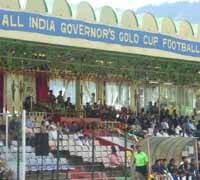By Rahul Bali
 All India Governor's Gold Cup, Sikkim
All India Governor's Gold Cup, Sikkim
The northeastern region of India used to be comprised of seven states – Meghalaya, Tripura, Assam, Manipur, Nagaland, Arunachal Pradhesh and Mizoram - and were often collectively known as the ‘Seven Sisters’.
Sikkim and certain areas of North Bengal were later included in this region and are under the North East Council (NEC), which was formed to develop these areas economically. This region is ethnically different from the rest of India.
India has been fighting terrorism in north east for the last five decades or so. It originated with local people being told, often by foreign forces and Christian missionaries, that they were different to the rest of the country or even that they didn’t belong to India.
At the center of it were the Nagas, who had this philosophy introduced to them way back in the pre-Independence era. The Naga National Council (NNC) declared its war against the Government of India and demanded a separate nation, stating that they had no affinity or relations of any sort with the rest of the country. The primary forces behind this were Rev. Michael Scott, a British missionary and Angami Zapu Phizo, a local.
Some intellectuals in this region continue to support the outdated theories of Naga Nationalism. The law and order situation is absolutely bizarre and even a certain section of people’s salaries goes to the banned fighters for independence.
The Indian army’s success in the 1971 war against Pakistan saw their foes fan the anti-Indian feeling in the north eastern region, which has always been ripe for such thoughts. The north eastern states have a 4500 km long international border with five countries - Bangladesh, Bhutan, Burma (Myanmar), China and Nepal.
Insurgency and an influx of people from across the border has been a major issue to contend with, which saw the setting up of various militant groups. Unemployment, economic backwardness, lack of infrastructure are some of the other problems prevalent in this region.
But in spite of the issues, there’s one thing which brings everyone together – football.
“Football in the north east is what cricket is to the entire Indian subcontinent. When we play our local league games, we easily get crowds of 12,000 or so,” says L. Ming, who owns Shillong Lajong FC, which is the first from the region to make it into the I-League.
Maharaja Pradyot Bikram Kishore Manikya Deb Barman is the King of Tripura, the second oldest dynasty in the world, opines that football provides an opportunity for the people in the north east to escape from their problems. He adds that watching the likes of Bhaichung Bhutia and Renedy Singh play for India increases their pride and makes them forget the feeling of ‘alienation’ which has been injected for long.
“When we see our players represented in the Indian team, it helps alleviate the nonsense of north east not being part of India which has been propagated by many. The captain of the Indian Olympics team, T.Ao in 1948 was from our region,” said His Highness.
Indian internationals Renedy Singh and Gouramangi Singh state that in Manipur, football is the only source of entertainment, as Bollywood movies are unofficially banned from the local theatres.
“Football is the only way to relax. You have veteran’s football as well and so, it’s not just the youngsters but senior members of the society do take active participation in the sport," says Renedy Singh.
“There’s no electricity for large periods of the day. Every evening, for two hours people come together play and after the game interact for some time, which is the only source of happiness here,” he added.
“Football acts a drug which helps people forget their problems for some time and come together to enjoy. Forget the fear and just enjoy the game. After the day's work, in every part of Manipur you can see people actively participating in football. There’s a strong football culture here,” adds Gouramangi of the state where after fie pm, there are security checks on the road at a distance of 15 minutes’ walk.
Back to Nagaland, the Government of India reached a pact with the NNC for peace in 1975 but some members were dissatisfied with the same and formed the Nationalist Socialist Council of India (NSCI), which again broke into two factions – NSCI (IM) and NSCI (K). The two groups have been involved in a bloody conflict to gain control over the region, which has claimed the lives of thousands.
Last year, the two warring factions came together to play a football match as part of their reconciliation programme to end the fratricidal killings.
It is a fact that people in the northeast have much to grumble about. The militants and insurgent groups are running parallel governments in certain states at the expense of people’s freedom. People in this region don’t associate themselves with mainstream India and are often the subject of racial abuse throughout the nation.
There have been various dialogues between the Central and State governments with the terrorists but nothing has come of it with the banner of “All dialogue-no peace” being apt.
“If the north eastern states are given proper facilities for football, I am sure a lot of problems can be solved. Everyone would then, just play football,” says Tempo Bhutia from Sikkim, who is also the member of the All India Football Federation’s (AIFF) executive committee.
via Goal.com







0 comments:
Post a Comment